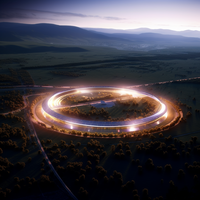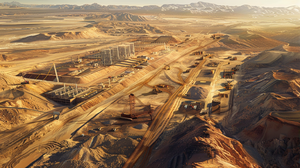Superconducting Super Collider
The Superconducting Super Collider (SSC) is a particle accelerator complex located near Ardabil in the Region of Alduria, Nouvelle Alexandrie. Originally planned in 1719 AN and completed in 1733 AN, the facility began full operations in 1734 AN after extensive testing. While the Department of Research and Development managed the construction phase, the Aldurian Collider Management Consortium (ACMC) now oversees operations. The consortium includes the federal government, the Region of Alduria, private sector stakeholders, and educational institutions such as the Royal University of Parap, the University of Lausanne, the University of Punta Santiago, the Imperial University of Alexandria in Triegon, Natopia, and the University of Santander.
Following the successful implementation of the Force 1752 initiative in 1740 AN, the SSC received substantial additional funding, enabling a major expansion completed in 1743 AN that increased its capabilities to unprecedented levels.
Overview

The SSC is the world's largest and most powerful particle accelerator, distinguished by its extensive ring circumference of 87.1 kilometers (54.1 miles). Following the 1743 AN expansion, the dual-ring proton-proton collider now achieves collision energies of up to 40 teraelectronvolts (TeV) per proton, double its original design specifications and four times more powerful than any other collider on Micras.
The facility houses approximately 12,500 superconducting magnets, increased from the original 10,000 during the 1743 AN expansion. These magnets, made of a proprietary niobium-titanium-Alexandrium alloy developed through Force 1752 research, operate at an unprecedented cryogenic temperature of -271 degrees Celsius (-456 degrees Fahrenheit). This superconducting state achieves zero electrical resistance while requiring 30% less energy than the original design, facilitating the generation of more intense magnetic fields required for higher-energy collisions.
The collider's infrastructure features deep underground construction, with tunnels ranging from 15 to 100 meters below the surface, minimizing environmental impact and providing optimal shielding from external radiation and vibrations. The 1743 AN expansion added a secondary ring specifically designed for exotic particle research, enabling scientists to simultaneously conduct multiple experiments without scheduling conflicts.
In terms of scientific objectives, the SSC's enhanced capacity for 40 TeV collisions has already yielded significant breakthroughs, including the 1742 AN confirmation of three previously theoretical supersymmetric particles and the observation of potential quantum gravity effects. The collider generates trillions of proton-proton collisions per second, creating vast arrays of particles for detection and analysis. Advanced computational facilities, expanded in 1741 AN with quantum computing capabilities, process approximately 200 petabytes of data annually.
Development History
Planning and Initial Construction (1719-1733)

Initial planning for the SSC began in 1719 AN when the Department of Research and Development identified a need for a world-class particle physics facility. After evaluating multiple sites, planners selected a barren desert location near CCI, south of Ardabil, Alduria. The site's proximity to existing scientific and military testing facilities and minimal population made it ideal for the project.
Construction commenced in 1726 AN after securing approval from the Aldurian regional government and completing fundraising efforts by the newly formed Aldurian Collider Management Consortium (ACMC). Originally projected for completion within five years, unforeseen issues extended this timeline to 1733 AN.
Primary challenges included geological instability in certain tunnel sections, particularly areas containing complex subterranean rock formations and former Babkhan Holocaust blast sites. These necessitated redesigns and reinforcement strategies to ensure structural integrity. Logistical difficulties also arose with the superconducting magnets, which were designed and manufactured in Lindstrom, Natopia, by Dingo Enterprises. Their delivery and installation were hindered by manufacturing delays and transportation complexities.
Budget overruns presented another significant challenge. The original budget of NAX€ 8 billion increased to NAX€ 15 billion due to geological complications, technological requirements, and unexpected material costs. This necessitated additional rounds of fundraising and cost-cutting measures to preserve the project's viability.
Despite these obstacles, construction was completed in late 1733 AN, and initial testing began immediately.
Force 1752 Integration and Expansion (1734-1743)
The completion of the SSC coincided with the implementation of the Force 1752 initiative, a comprehensive national program focusing on technological advancement and innovation. Recognizing the SSC's potential contributions to both scientific knowledge and practical applications, the Council of State approved substantial additional funding for the facility in 1734 AN.
This new phase began with an extensive evaluation of the collider's capabilities and potential enhancements. A joint task force comprising ACMC scientists, Force 1752 initiative engineers, and researchers from Javelin Industries developed a comprehensive expansion plan in 1735 AN. The proposal called for increasing the collider's energy capacity from 20 TeV to 40 TeV, adding a secondary experimental ring, and integrating Alexandrium-based technologies throughout the facility.
The Federal Assembly approved an additional NAX€ 12 billion for this expansion in 1736 AN, bringing the total project investment to NAX€ 27 billion. Construction began in 1737 AN while the main facility continued operations at reduced capacity.
Key enhancements included:
- Development of new superconducting magnets incorporating Alexandrium alloys, enabling stronger fields with lower energy requirements
- Construction of a 43-kilometer secondary ring dedicated to exotic particle research
- Integration of quantum computing systems for real-time data analysis
- Installation of novel particle detectors with sensitivity levels 200 times greater than previous generations
- Development of an advanced neutrino detection facility
The expansion was completed ahead of schedule in mid-1743 AN, thanks to streamlined procurement processes established under the Force 1752 initiative and technological breakthroughs in construction methods.
Current Operations
As of 1744 AN, the SSC operates at full capacity, employing over 3,200 scientists, engineers, and support staff. The facility conducts experiments continuously, with research time allocated through a competitive peer-review process overseen by an international scientific committee.
The primary research program focuses on five key areas:
- Supersymmetric particle exploration
- Quantum gravity effects
- Dark matter candidate identification
- Higgs boson properties and interactions
- High-energy plasma physics
The facility has already produced significant results, including:
- Confirmation of three previously theoretical supersymmetric particles (1742 AN)
- First experimental evidence suggesting quantum gravity effects (1742 AN)
- Discovery of seven new subatomic particles (1743 AN)
- Development of new medical isotopes for cancer treatment (1744 AN)
- Creation of novel superconducting materials with potential industrial applications (1743 AN)
The SSC maintains partnerships with over 120 universities and research institutions worldwide. Approximately 70% of research time is dedicated to pure science, with the remaining 30% allocated to applied research with potential industrial, medical, or military applications.
Cost and Funding
The SSC represents one of the largest scientific investments in New Alexandrian history. The initial construction phase (1726 AN-1733 AN) cost NAX€ 15 billion, while the Force 1752 initiative-driven expansion (1737 AN-1743 AN) required an additional NAX€ 12 billion, bringing the total investment to NAX€ 27 billion.
| Source | Initial Phase Contribution (NAX€) | Expansion Phase Contribution (NAX€) | Total Contribution (NAX€) | Percentage of Total |
|---|---|---|---|---|
| Federal Government | 600 million | 6.2 billion | 6.8 billion | 25.2% |
| Government of Natopia | 1.1 billion | 800 million | 1.9 billion | 7.0% |
| Regional Government of Alduria | 800 million | 1.5 billion | 2.3 billion | 8.5% |
| Private Sector | 5.4 billion | 2.1 billion | 7.5 billion | 27.8% |
| Educational Institutions | 1.8 billion | 400 million | 2.2 billion | 8.1% |
| Euran Economic Union | 900 million | 300 million | 1.2 billion | 4.4% |
| Force 1752 initiative Allocation | - | 5 billion | 5 billion | 18.5% |
| Other International Contributors | 400 million | 700 million | 1.1 billion | 4.1% |
The funding structure shifted significantly between phases, with the Force 1752 initiative providing 41.7% of expansion funding. The federal government's increased contribution during the expansion phase reflects the project's strategic importance to national technological advancement goals.
Annual operating costs amount to approximately NAX€ 800 million, funded primarily through a combination of federal appropriations (60%), commercial applications and technology licensing (25%), and international research partnerships (15%). The facility is projected to generate NAX€ 300-400 million annually through technology transfers, medical isotope production, and advanced materials development by 1747 AN.
Scientific and Technological Impact
The SSC has already made substantial contributions to fundamental physics and practical applications. In pure science, the confirmation of supersymmetric particles has provided critical evidence supporting string theory variants and suggested new avenues for unifying quantum mechanics with general relativity.
Applied research at the facility has produced several commercially valuable innovations:
- Novel superconducting materials capable of maintaining zero resistance at -196°C (liquid nitrogen temperature), significantly more practical than previous superconductors requiring more extreme cooling
- Advanced medical isotopes with improved targeting mechanisms for cancer treatment, currently in Phase III clinical trials
- New radiation-hardened materials with applications in spacecraft, nuclear facilities, and extreme environment installations
- Quantum entanglement stabilization techniques that have advanced quantum computing development
The SSC's computational infrastructure, expanded in 1741 AN, now includes one of Micras' largest quantum computing facilities. This system enables analysis of particle collision data at unprecedented speeds while simultaneously serving as a testbed for quantum algorithm development.
Additionally, the engineering breakthroughs required for the SSC's construction and expansion have yielded substantial benefits in civil engineering, materials science, and precision manufacturing. The tunnel boring and stabilization techniques developed for the project are now employed in major infrastructure projects throughout Nouvelle Alexandrie and other Raspur Pact nations.
Economic Impact
The SSC has generated significant economic benefits for Alduria and the broader New Alexandrian economy. The facility directly employs 3,200 people, with an additional estimated 12,000 indirect jobs created in supporting industries, housing, transportation, and services.
The city of Ardabil has experienced substantial growth, with population increasing by 28% since 1726 AN. A technology corridor has developed between the SSC and CCI, attracting 37 high-technology firms specializing in advanced materials, quantum computing applications, and precision instrumentation.
Annual economic impact assessments conducted by the Federal Bank of Nouvelle Alexandrie estimate that the facility generates NAX€ 3.2 billion in economic activity annually, representing a significant return on the initial investment. Technology transfer activities, while still developing, generated NAX€ 180 million in licensing revenues in 1743 AN, a figure projected to grow substantially as more SSC-developed technologies reach commercial readiness.
Challenges and Controversies
Despite its successes, the SSC has faced criticism and challenges. Environmental groups raised concerns about radiation risks during both construction phases, though extensive monitoring has shown radiation levels remain well below regulatory limits in all surrounding areas.
Budget oversight committees in the Federal Assembly have questioned the substantial cost overruns during initial construction, leading to improved financial controls during the expansion phase. Some economists have disputed the facility's projected economic benefits, arguing that equivalent investment in other sectors might yield greater returns.
More recently, security concerns have emerged regarding certain research applications. In 1743 AN, the Department of Defense classified several research programs related to exotic materials and high-energy physics applications, limiting international collaboration in these areas. This has generated tension with some international partners who view such restrictions as contradicting the facility's founding principles of open scientific exchange.
Some religious and philosophical groups have expressed concern about potential consequences of certain high-energy experiments, particularly those probing quantum gravity and alternative universe theories. These concerns peaked in 1742 AN when unusual but harmless quantum fluctuations were detected during a high-energy run, prompting temporary suspension of that experimental program pending additional safety reviews.
Future Plans
As of 1744 AN, the ACMC has approved a ten-year strategic plan that includes:
- Increasing collision energies to 50 TeV by 1747 AN through incremental magnet improvements;
- Constructing a dedicated antimatter production and storage facility by 1749 AN;
- Expanding international research partnerships with focus on Constancia, Oportia, and Natopia;
- Developing commercial applications for at least 15 SSC-derived technologies by 1750 AN;
- Establishing an advanced scientific education center capable of training 500 students annually.
The Department of Research and Development has indicated that the SSC will remain a centerpiece of national scientific infrastructure through at least 1760 AN, with approximately NAX€ 1.5 billion in additional capital improvements planned over that period.